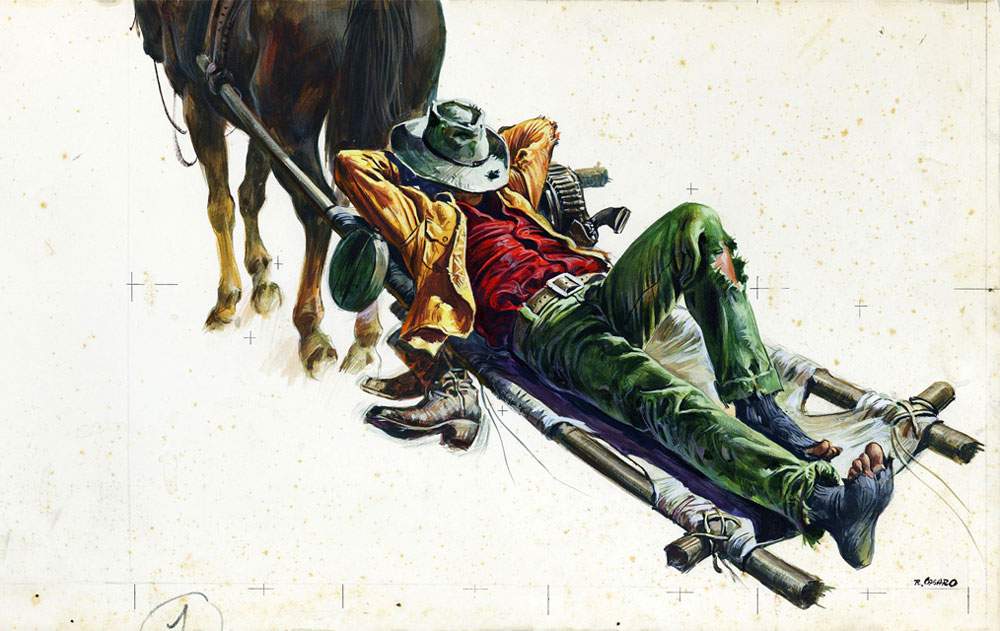From March 28 to Sept. 30, 2021, Treviso celebrates the last of the great movie poster artists, Renato Casaro (Treviso, 1935), with a major exhibition divided among three venues. The last protagonist of a vanished art, Renato Casaro is credited with the posters of great masterpieces of cinema, from Cinecittà to Hollywood.
The exhibition will take place between the new Museo Nazionale Collezione Salce, the Complesso di San Gaetano and the Musei Civici di Santa Caterina, and will be curated by Roberto Festi and Eugenio Manzato, with the collaboration of Maurizio Baroni, three specialists in the field, who have analyzed Casaro’s enormous archive, consisting of more than 1,000 posters and playbills, selecting evidence of an artistic journey that lasted 50 years.
Casaro’s connection with cinema began when, while still a boy, he created the large hand-painted silhouettes that were placed at the entrance to the Garibaldi Theater Cinema and the Esperia Cinema in Treviso. At nineteen he left for Rome where he found work in Augusto Favalli’s studio and where he stayed for about a year and a half learning the techniques and tricks of the trade. Criminals Against the World (1955) is his first official manifesto, and in 1957, also in Rome, he opened his own studio.
A craftsman of genius, from the very beginning Casaro measured his art against what Cinecittà and international cinema were proposing: his style conquered great directors and Hollywood: Jean-Jacques Annaud, Dario Argento, Marco Bellocchio, Ingmar Bergman, Bernardo Bertolucci, Luc Besson, John Boorman, Tinto Brass, Liliana Cavani, Francis Ford Coppola, Milos Forman, Costa-Gavras, Pietro Germi, Claude Lelouch, Ugo Liberatore, Sergio Leone, Sidney Lumet, Anthony Mann, Mario Monicelli, Francesco Rosi, Alberto Sordi, John Sturges, Giuseppe Tornatore, François Truffaut, Carlo Vanzina, Carlo Verdone...
The exhibition documents 170 films starting with two- and four-sheet posters intended for movie theaters or for posting. About 100 pieces were selected and restored for the occasion. The rare sheets from the decade 1955-1965, which have never been shown in an exhibition, present a rapidly developing artist who, thanks to the fertile Roman environment, where Cinecittà was in those years one of the most prolific industries, was able to give his best in every genre. Thus are juxtaposed, in the great “terrace” of the Santa Margherita, Trinity and Rambo or the unforgettable posters of such masterpieces as The Magnificent Seven, Once Upon a Time in America, Amadeus, The Name of the Rose, Tea in the Desert, The Last Emperor.
Following a chronological but also thematic progression, the exhibition juxtaposes the large, multicolored posters with a selected series of studio sketches and originals from the artist’s archives and important public and private collections.
This allows us to understand the artist’s activity and style, but also the technical innovations that Casaro adopted and developed over the years: from the instinctive brushstrokes of his early days, to the partly photographic compositions of the 1970s, to the refined airbrush maquettes that made him famous, particularly in portraits of leading actors, between the 1980s and 1990s. It earned him collaborations with major American production companies (Fox, United Artists, MGM, Columbia).
A previously unseen video, produced by FilmWork, will be shown in the three exhibition venues, showing the public trailers and excerpts from films for which Casaro curated the iconographic equipment and some of his reflections on his professional career.
The Treviso, Rome, Hollywood section unfolds in the Santa Caterina Civic Museums, a roundup of works that match and complement those presented, under the title The Last Posterist, in the innovative Santa Margherita venue where an educational section has also been set up and where younger visitors can, in total autonomy, create their own movie poster. Also, a section dedicated to the visually impaired with a three-dimensional reproduction of the famous poster Tea in the Desert. A third section, titled From the idea to the poster, is set up in the spaces of the San Gaetano complex: here the public can discover the entire chain for the creation of a poster, from contacts with production or distribution companies to the first pencil sketches; from the test sketch-often with the variants requested, or imposed, by the client-to the executive sketch, up to the study for the insertion of lettering and printing. Six of Casaro’s iconic films tell, with a strong educational value, the whole technical and artistic world behind the creation of a poster.
For info: www.museicivicitreviso.it; www.collezionesalce.beniculturali.it
Image: Renato Casaro, They Called Him Trinity (1970; Casaro Archive)
 |
| In Treviso a major exhibition dedicated to Renato Casaro, the last great poster designer of cinema |
Warning: the translation into English of the original Italian article was created using automatic tools. We undertake to review all articles, but we do not guarantee the total absence of inaccuracies in the translation due to the program. You can find the original by clicking on the ITA button. If you find any mistake,please contact us.